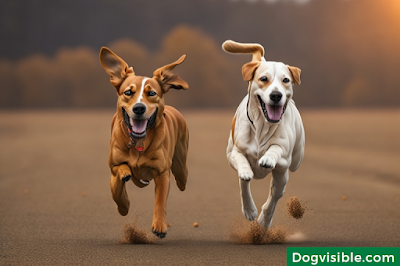How Fast is a Dog - Dogvisible
Dogs are remarkable creatures known for their loyalty, companionship, and incredible range of abilities. One intriguing aspect of their nature is their speed. Have you ever wondered, "How fast is a dog?"
Join us on this exhilarating journey as we explore the remarkable athleticism and speed exhibited by our furry friends. From the factors influencing their velocity to the fastest dog breeds and the fascinating world of dog agility, we will unveil the secrets behind their swift movements.
IN THIS ARTICLE
- How Fast is a Dog?
- Factors Influencing Dog Speed
- Breeds Renowned for Speed: How Fast is a Dog
- Training for Speed: How Fast is a Dog
- Summary
How Fast is a Dog?
Understanding the speed of a dog entails considering various factors, including breed, size, and physical attributes. However, on average, a healthy dog can run at speeds ranging from 20 to 30 miles per hour (32 to 48 kilometers per hour). This impressive pace showcases the agility and dexterity that dogs possess. To comprehend the variations in speed across breeds and factors that contribute to their swiftness, let's dive deeper into the world of canine velocity.
Factors Influencing Dog Speed
Several factors contribute to the speed of a dog. These elements include genetics, size, muscle composition, and overall physical fitness.
Let's take a closer look at how these factors affect a dog's speed.
1. Genetics: The Speed Blueprint
Different dog breeds have distinct physical attributes that influence their speed. Some breeds have been selectively bred for centuries to excel in specific tasks, such as herding, hunting, or racing. Greyhounds, known as the fastest dog breed, possess slender bodies, elongated limbs, and a deep chest, enabling them to reach astonishing speeds of up to 45 miles per hour (72 kilometers per hour).
2. Size and Body Structure: Smaller but Faster?
Size plays a role in determining a dog's speed. Generally, smaller breeds tend to be quicker than larger ones. This is due to their lighter body weight and more compact build, which reduces resistance and allows for swifter movements. For instance, the energetic Jack Russell Terrier can clock impressive speeds of around 25 miles per hour (40 kilometers per hour).
3. Muscle Composition: Powering the Sprint
The muscular composition of a dog significantly affects its speed potential. Breeds with well-developed, lean muscles exhibit enhanced power and agility, enabling them to sprint with remarkable velocity. The sleek and muscular Whippet is a prime example, capable of reaching speeds of up to 35 miles per hour (56 kilometers per hour).
4. Individual Fitness and Training: Training for Speed
Just like humans, a dog's physical fitness and training regimen greatly impact its speed. Regular exercise, conditioning, and specialized training programs can improve a dog's speed and endurance. Proper nutrition and a healthy lifestyle also play vital roles in enhancing their overall athletic capabilities.
5. Environmental Factors: Maximize Their Speed
Dogs' speed can also be influenced by external elements. Terrain, weather conditions, and temperature all contribute to their overall performance. Dogs often excel on open, flat surfaces that allow them to maximize their speed, whereas rough terrains or extreme weather can hinder their abilities.
Breeds Renowned for Speed: How Fast is a Dog
Certain dog breeds stand out for their extraordinary speed. Let's take a look at some of the fastest breeds that can leave us in awe of their rapid movements.
Greyhound: The Speed Demon
As mentioned earlier, the Greyhound is hailed as the fastest dog breed in the world. Their remarkable speed and grace make them ideal candidates for professional racing events. These elegant canines effortlessly sprint across tracks, showcasing their incredible talent.
Saluki: The Arabian Gazelle Hound
The Saluki, often referred to as the "Gazelle Hound," is another breed known for its exceptional swiftness. Originally bred for hunting in the desert, these slender dogs possess a combination of agility, endurance, and speed that allows them to cover vast distances swiftly.
Border Collie: The Agile Worker
Although primarily recognized for their intelligence and herding instincts, Border Collies are also impressively agile and quick. Their remarkable speed and agility aid them in efficiently controlling livestock and maneuvering through challenging terrains.
Dalmatian: The Energetic Sprinter
While commonly associated with their distinct spots and friendly demeanor, Dalmatians are also surprisingly fast. Their lean physique and strong legs allow them to achieve notable speeds, making them excellent companions for activities such as running or agility training.
Vizsla: the stamina and agility
Vizslas, known for their striking appearance and affectionate nature, possess a combination of speed and endurance. Originally bred as hunting dogs, they have the stamina and agility to cover significant distances at an impressive pace.
Australian Cattle Dog: Boasts Remarkable Speed
The Australian Cattle Dog, renowned for its herding skills and intelligence, also boasts remarkable speed. Their compact yet muscular build aids them in swiftly maneuvering livestock, showcasing their agility and quick reflexes.
Siberian Husky: Endurance in Sled Racing
While Siberian Huskies are famous for their endurance in sled racing, they also possess considerable speed. These energetic dogs can reach remarkable velocities, particularly when pulling a sled in a team.
Belgian Malinois: Excel in Various Tasks
As versatile working dogs, Belgian Malinois exhibit remarkable speed and agility. Their athleticism and drive enable them to excel in various tasks, including police and military work, search and rescue, and competitive dog sports.
Training for Speed: How Fast is a Dog
To enhance a dog's speed, specialized training techniques can be employed.
Here are a few methods that can help improve their swiftness and agility:
- Interval Training: Interval training involves alternating between periods of high-intensity exercise and recovery. This type of training improves cardiovascular fitness, builds endurance, and enhances a dog's speed by pushing its limits.
- Sprint Training: Dedicated sprint sessions can focus on developing a dog's explosive speed. Short, intense bursts of running followed by rest periods can improve their ability to accelerate quickly.
- Plyometric Exercises: Incorporating plyometric exercises into a dog's routine can enhance its power and agility. These exercises, such as hurdle jumps and bounding, improve muscle strength and coordination, resulting in faster and more efficient movements.
- Obstacle Courses: Setting up obstacle courses with various hurdles, tunnels, and weave poles can challenge a dog's agility and speed. These courses simulate real-life scenarios and promote quick thinking and precise movements.
SUMMARY
Dogs possess an inherent ability for speed and agility, each breed showcasing its unique capabilities. From the lightning-fast Greyhound to the agile Border Collie, our canine companions continue to captivate us with their athletic prowess. Understanding the factors influencing their speed, such as breed genetics, size, muscle composition, and environmental factors, allows us to appreciate their incredible abilities better.
Whether you're considering adopting a high-speed breed or simply want to improve your dog's athleticism, training techniques such as interval training, sprint sessions, plyometric exercises, and obstacle courses can help enhance their speed and agility. Remember to prioritize their well-being and consult with professionals to ensure safe and effective training practices.
Now that you have gained a deeper understanding of how fast dogs can be, you can appreciate the astonishing capabilities of these remarkable creatures. So, lace up your running shoes and embark on an adventure with your furry friend, cherishing every moment of their lightning-fast companionship.








